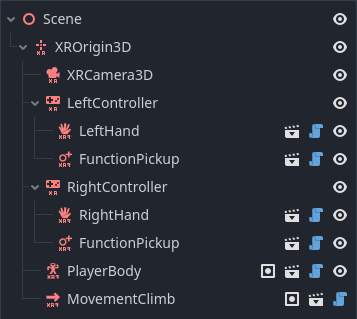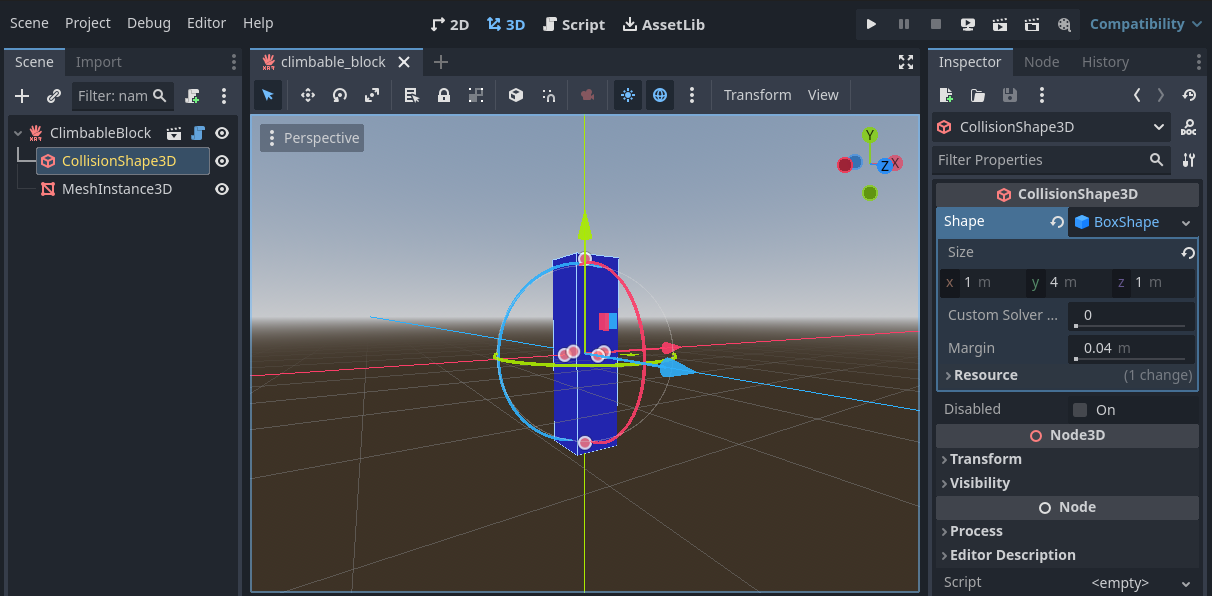Climbing
Introduction
Climbing in games has been a staple for decades, with modern games like Uncharted or Tomb Raider having the player scaling mountains, making death defying jumps, or trying to reach treasure.
None of those however compare to the experience of climbing in VR. It is so good that some of the best-selling VR games such as The Climb use it as their primary mechanic. Danging hundreds of meters above the ground hanging off a cliff face is as close as you can get in gaming to the real thing. The sense of vertigo is real enough to give the player a real fear of letting go, yet without the tiring of arms and the risk of actual injury.
The climbing mechanic in VR is also one of the few where moving the player through the world, while the player in reality is standing still in their room waving their arms around, tricks the brain enough to fight off motion sickness.
The climbing system in XR tools is very versatile but as it combines a few objects together does take a bit more setup then some of the other movement functions. It can also be combined with the other movement functions so you can use direct movement to walk up to a wall, and then use the climbing function to scale the wall.
Setup
As mentioned setting up the climbing system requires a few more steps.
First, the climbing function uses our pickup function from the Pickup and throw system. You thus need to add the Pickup functions to both hands.
NOTE: Static body 3D collisions for Jolt physics are not detected by default which is needed for the pickup_function to work properly, this is disabled by default, to enable go to project_settings > Jolt > Collisions > Areas_Detect_Static_Bodys and enable it. Jolt Detect Static Bodies
Next you need to add the Climb movement function as a child to the XROrigin3D node, note that as with other movement functions, this will add a PlayerBody node to your XROrigin3D node if it doesn’t already exist.
Your setup should now look like this:

Now that our player is able to climb, we need to define the things they can climb
on. This is accomplished by inheriting the objects/climbable.tscn scene,
simply open the Scene menu, select New Inherited Scene… and select the
climbable.tscn scene from the xr tools library. This scene sets up a static
body with a collision shape and a script that allows you to grab that static body.
When the player grabs the static body moving your hand will cause the player to
move instead of the hand.
You can create small objects to create climbing anchors that the player must grab and create an experience where the player needs to be very precise, or you can just create one big collision shape the player can climb on without caring much about where the player holds the shape.
We’re taking the latter as an example, the screenshot below sets up a scene, I’ve
renamed the root node, added a MeshInstance with a box, and then added a collision
shape to the CollisionShape node giving it the same size as the block:

Now save the scene and add it to your main scene and your player can climb the block.
See Climbable objects for more details.
Configuration
XRToolsMovementClimb
| Property | Description |
|---|---|
| Enabled | When ticked this node will control the player’s movement. |
| Order | The order in which this movement is processed in case multiple movement functions are active. |
| Forward Push | When the player lets go they are pushed away from the object they were holding by this force |
| Fling Multiplier | If the player lets go their current momentum is multiplied by this amount allowing the player to “fling” themselves off a wall. |
| Velocity Averages | The number of velocity samples to take to determine the player’s velocity when they let go. |
Additional Resources
The following videos show the creation of a basic XR Player with movement including climbing: